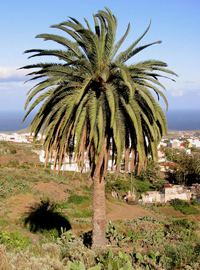About Palm-Leaves, -Branches and -Trees
All data was taken from the english wikipedia
Leaves
In botany,
a leaf is an above-ground plant
organ
specialized for photosynthesis.
For this purpose, a leaf is typically flat (laminar) and thin, to expose
the cells containing chloroplast
to light
over a broad area, and to allow light to penetrate fully into the tissues.
Leaves are also the sites in most plants where transpiration
and guttation
take place. Leaves can store food
and water,
and are modified in some plants for other purposes. The comparable structures
of ferns and
palm trees are correctly referred to as fronds.
Furthermore, leaves are prominent in the human
diet
as leaf
vegetables.
palm fronds / palm branches
![]() A
palm branch (or palm frond
or palm stem),
usually refers to the leaves of the Arecaceae
(sometimes known by the names Palmae).
A
palm branch (or palm frond
or palm stem),
usually refers to the leaves of the Arecaceae
(sometimes known by the names Palmae).
The palm branch
was a symbol of triumph and victory in pre-Christian
times. The Romans
rewarded champions of the games and celebrated military successes with palm
branches. The motto of the HMS
Nelson and the University
of Southern California is "Palmam qui meruit ferat", which
means in Latin,
"Let him bear the palm who has deserved it". Jews followed a similar
tradition of carrying palm branches during festive times.
palm trees / Aracaceae
 Arecaceae
or Palmae (also known by the name Palmaceae,
which is taxonomically invalid[1]
or commonly palm tree), the palm family, is a family of
flowering
plants belonging to the monocot
order, Arecales. There are roughly 202 currently known
genera with
around 2600 species,
most of which are restricted to tropical,
subtropical,
and possibly warm temperate
climates. Most palms are distinguished by their large, compound, evergreen
leaves arranged
at the top of an unbranched stem. However, many palms are exceptions to
this statement, and palms in fact exhibit an enormous diversity in physical
characteristics. As well as being morphologically diverse, palms also inhabit
nearly every type of habitat
within their range, from rainforests
to deserts.
Arecaceae
or Palmae (also known by the name Palmaceae,
which is taxonomically invalid[1]
or commonly palm tree), the palm family, is a family of
flowering
plants belonging to the monocot
order, Arecales. There are roughly 202 currently known
genera with
around 2600 species,
most of which are restricted to tropical,
subtropical,
and possibly warm temperate
climates. Most palms are distinguished by their large, compound, evergreen
leaves arranged
at the top of an unbranched stem. However, many palms are exceptions to
this statement, and palms in fact exhibit an enormous diversity in physical
characteristics. As well as being morphologically diverse, palms also inhabit
nearly every type of habitat
within their range, from rainforests
to deserts.
Palms are one of the most well-known and extensively cultivated plant families.
They have had an important role to humans throughout much of history. Many
common products and foods are derived from palms, and palms are also widely
used in landscaping for their exotic appearance, making them one of the
most economically important plants. In many historical cultures, palms were
symbols
for such ideas as victory, peace, and fertility. Today, palms remain a popular
symbol for the tropics and vacations.
